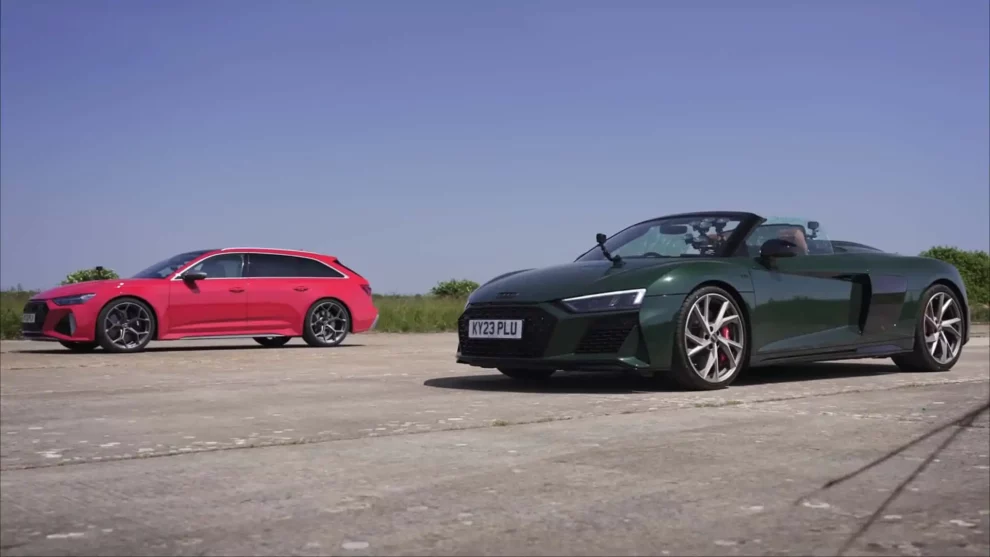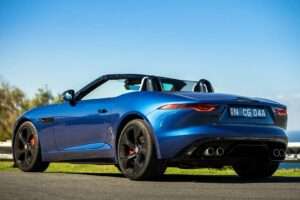Audi’s latest masterpiece, the RS 6 Avant GT, has demonstrated its remarkable capabilities by going head-to-head with the legendary R8 GT supercar. The results have left automotive enthusiasts worldwide in awe, with only a fraction of a second separating these two distinctly different machines in quarter-mile drag races.
The RS 6 Avant GT, Audi’s swan song for the C8-generation A6 lineup, represents the pinnacle of performance wagon engineering. Limited to just 660 units globally, with a mere 85 units destined for the United States market in 2025, this exceptional vehicle pays homage to the iconic Audi 90 quattro IMSA GTO racing car. With a starting price of $198,900, it’s clear that this isn’t your typical family hauler.
Under the hood, the RS 6 Avant GT showcases Audi’s engineering prowess with a twin-turbocharged V8 engine that produces an astounding 621 horsepower and 627 pound-feet of torque. This powerplant is mated to ZF’s renowned 8HP automatic transmission, which channels power through Audi’s sophisticated quattro all-wheel-drive system. During normal operation, the torque-sensing permanent all-wheel-drive system maintains a 40:60 front-to-rear split, but it can dynamically adjust to send up to 85 percent of power to the rear wheels or 70 percent to the front wheels as conditions demand.
However, this technological tour de force comes with a weight penalty. The RS 6 Avant GT tips the scales at a substantial 4,575 pounds, though this figure still compares favorably to its direct competitor, BMW’s upcoming M5 Touring, which adds hybrid components to a similar twin-turbo V8 formula. Despite its heft, the RS 6 Avant GT’s performance capabilities are nothing short of remarkable.
In contrast, the R8 GT represents the pure sports car approach to performance. Equipped with one of the most celebrated engines in modern automotive history – a naturally aspirated 5.2-liter V10 FSI engine – this rear-wheel-drive supercar produces 612 horsepower and 417 pound-feet of torque. The R8 GT’s significant weight advantage, coming in at just 3,461 pounds, combined with its dual-clutch transaxle from Dana Graziano, makes it a formidable opponent on any drag strip.

In a series of tests conducted by carwow’s Mat Watson and Rory White, these two automotive titans engaged in both standing-start quarter-mile runs and rolling races. The results were nothing short of spectacular, with the RS 6 Avant GT completing the quarter-mile in 11.5 seconds, while the R8 GT crossed the finish line in 11.4 seconds – a difference that showcases the incredible engineering achievement of making a family wagon perform nearly on par with a purpose-built supercar.
The rolling races, however, told a different story. Whether starting from 50 mph in second gear or 80 mph in third, the R8 GT’s lighter weight and more focused performance orientation gave it a clear advantage. This superiority extended to top speed capabilities, with the R8 GT capable of reaching 199 mph, compared to the RS 6 Avant GT’s still impressive 190 mph maximum velocity.
What makes these results particularly remarkable is the RS 6 Avant GT’s versatility. While it can nearly match a supercar in straight-line acceleration, it still offers the practicality of a wagon body style, comfortable seating for five, and substantial cargo capacity. This duality of purpose represents the culmination of Audi Sport’s engineering expertise and showcases how far performance car technology has advanced.
As Audi prepares to transition to the C9-generation A7 in early 2025, the RS 6 Avant GT serves as a fitting finale for the current generation. Its performance capabilities, especially when compared to a dedicated supercar like the R8 GT, demonstrate that the lines between different automotive segments continue to blur. For context, both Audis’ quarter-mile times approach that of the Chevrolet Corvette Z06, which officially claims a 10.6-second run.
The RS 6 Avant GT stands as a testament to Audi’s commitment to pushing the boundaries of what’s possible in a performance wagon. While its limited production run ensures exclusivity, its near-supercar performance combined with everyday usability makes it a unique proposition in the automotive landscape. As manufacturers increasingly turn toward electrified powertrains, this vehicle might well be remembered as one of the last great examples of traditional performance engineering meeting practical design.
















Add Comment